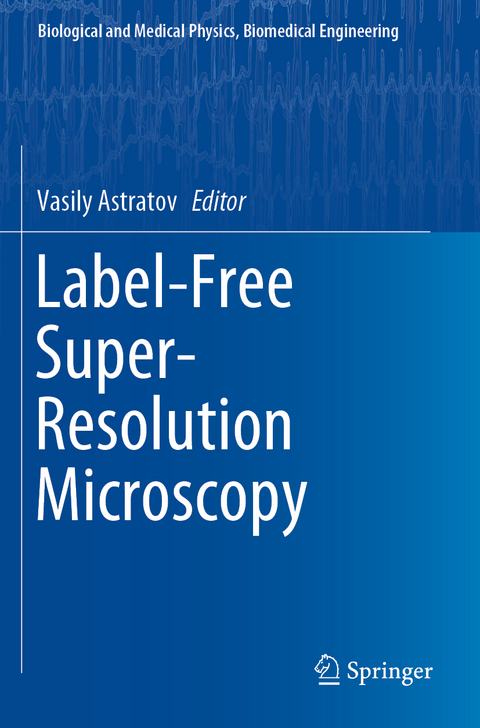
Label-Free Super-Resolution Microscopy
Springer International Publishing (Verlag)
978-3-030-21724-2 (ISBN)
Vasily N. Astratov has been professor of Physics and Optical Science at the University of North Carolina-Charlotte since 2002. In 1986, he received his Ph.D. degree from the A.F. Ioffe Physical-Technical Institute in Russia. Since joining UNC-Charlotte in 2002, his research has been devoted to a new field of study which he has named "microspherical photonics" to describe the applications of dielectric microspheres in super-resolution microscopy, resonant light forces, photonic nanojets, and photonic molecules. In his lab, he proposed and developed the methods of super-resolution imaging based on using high-index dielectric microspheres immersed in liquids or in elastomeric slabs. His methods are widely used by many groups worldwide for imaging subcellular structures, viruses, and nanoplasmonic structures. He also observed giant light forces exerted on microspheres under resonant conditions with their whispering gallery modes. This observation builds upon earlier pioneering work of Arthur Ashkin and Joseph M. Dziedzic on optical forces exerted on microdroplets. Previously, in the mid-1990s he pioneered studies of synthetic opals as novel three-dimensional photonic crystals for visible light. He has authored and co-authored about 180 research publications and 15 patents which have been cited more than 6000 times.
1. Introduction (Vasily Astratov).- 2. Optical Resolution, Field Entropy, and Heisenberg's Uncertainty Relation (Gabriel Popescu).- 3. Interferometric Scattering Microscopy (iSCAT) and Related Techniques (Vahid Sandoghdar).- 4. Label-Free, Ultrahigh-Speed Direct Imaging of Bio-Nanoparticles in Live Cells by Coherent Brightfield (COBRI) Microscopy (Chia-Lung Hsieh.- 5. Super-Resolution Imaging in Raman Microscopy (Katsumasa Fujita).- 6. Toward Label-Free Superresolution Microscopy (Renee Frontiera).- 7. Label-Free Time Multiplexing Based Nanoscopy (Zeev Zalevsky).- 8. Beating the Diffraction Limit in IR Microscopy Through Detecting the Thermal Effect (Ji-Xin Cheng).- 9. Superresolution Imaging Based on Nonlinear Scattering (Shi-Wei Chu).- 10. Label Free Superresolution by Nonlinear Photo-Modulated Reflectivity (Ori Cheshnovsky) .- 11. Hyper-Structured Illumination: Label-Free Super-Resolution Imaging with Hypebolic Metamaterials (Evgenii Narimanov).- 12. Superresolution MicroscopyTechniques Based on Plasmonics and Transformation Optics (. Igor Smolyaninov and Vera Smolyaninova).- 13. Superlensing Particle Lenses for White-Light Super-Resolution Imaging (Zengbo Wang and Boris Luk'yanchuk).- 14. Theoretical Foundations of Superresolution in Microspherical Nanoscopy (Alexey Maslov and Vasily Astratov).- 15. Role of Plasmonics in Super-Resolution Imaging Through Microspheres (Vasily Astratov's group at UNC-Charlotte).- 16. Plasmonics Meets Far-Field Optical Nanoscopy (Fernando Stefani (to be confirmed)).- 17. Superoscillatory Focusing Technologies and Quantum Superoscillation (Nikolay Zheludev and Edward Rogers (to be confirmed)).- 18. Perfect Imaging via Transformation Optics (Ulf Leonhardt (to be confirmed)).- 19. Focusing and Imaging from the Far Field Using Time Reversal in Subwavelength Scaled Resonant Media (Fabrice Lemoult & Geoffroy Lerosey (to be confirmed)).
"A thorough and cutting-edge reference of the modern advances in microscopy, the book is valuable reading for researchers and physicists." (Silvano Donati, Optics & Photonics News, March 19, 2020)
| Erscheinungsdatum | 22.09.2020 |
|---|---|
| Reihe/Serie | Biological and Medical Physics, Biomedical Engineering |
| Zusatzinfo | XXII, 487 p. 244 illus., 222 illus. in color. |
| Verlagsort | Cham |
| Sprache | englisch |
| Maße | 155 x 235 mm |
| Gewicht | 913 g |
| Themenwelt | Naturwissenschaften ► Chemie ► Analytische Chemie |
| Naturwissenschaften ► Chemie ► Physikalische Chemie | |
| Naturwissenschaften ► Physik / Astronomie | |
| Schlagworte | Biological Microscopy • Interferometric scattering microscopy • Label-free Imaging • Label-free Nanoscopy • Label-free Super-resolution • Label-free Super-resolution Microscopy • Microspherical Nanoscopy • optical nanoscopy • Plasmonics in Super-Resolution Imaging • Superresolution Microscopy • super-resolved fluorescence microscopy |
| ISBN-10 | 3-030-21724-8 / 3030217248 |
| ISBN-13 | 978-3-030-21724-2 / 9783030217242 |
| Zustand | Neuware |
| Haben Sie eine Frage zum Produkt? |
aus dem Bereich


